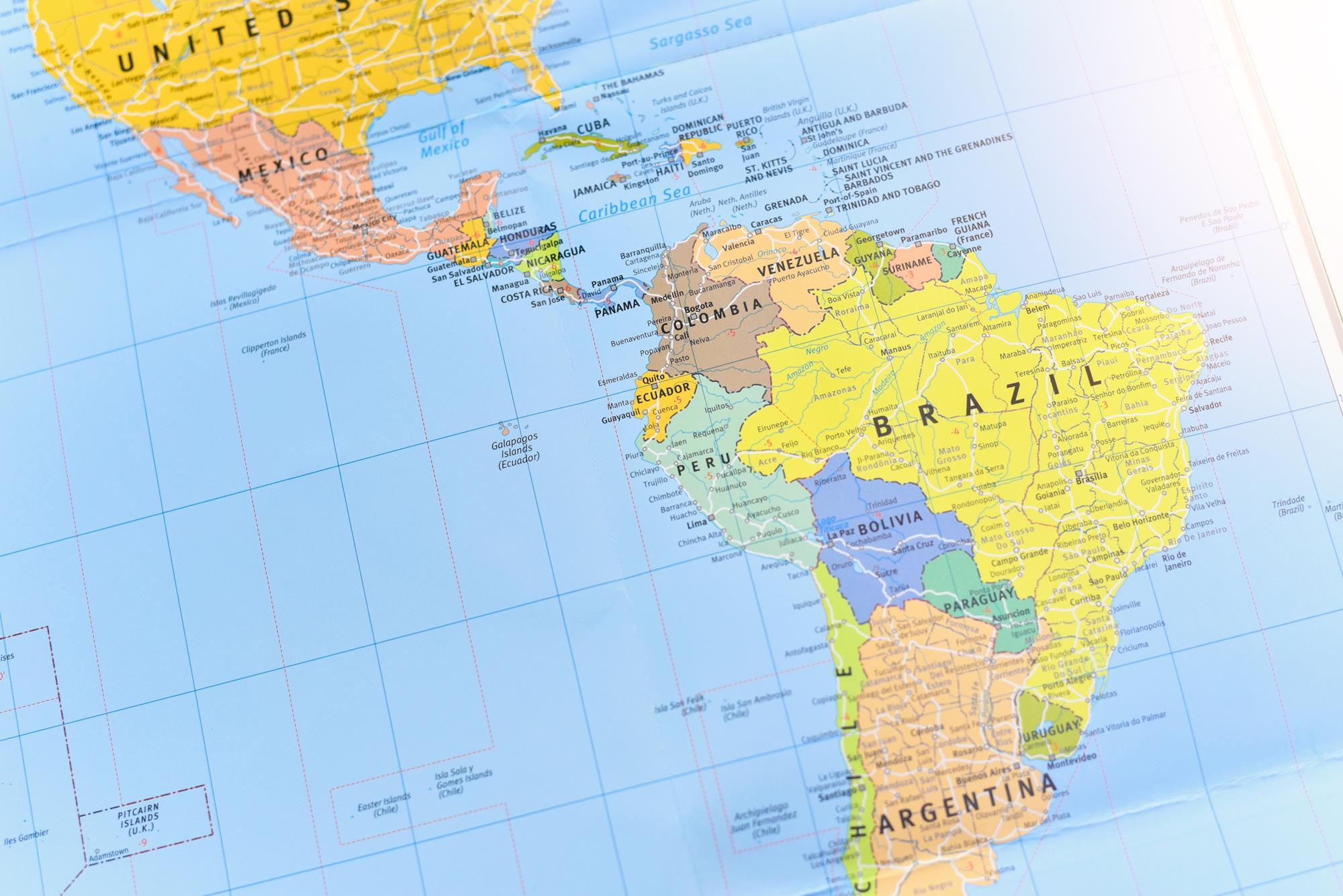RIO DE JANEIRO, BRAZIL – Michel Chevalier was a French engineer and economist, charged by his country’s government with drawing up an assessment of the financial situation in the Americas in 1836. The term “Latin America” is credited to him and to his study.

Unlike the case of the United States, where America and the term “American” itself were encouraged as a means of establishing distance from the English colonizers (against whom the country had fought to split), the concept of “Latin” was born as a way of strengthening the region’s ties with its European metropolises.
During his visit, Chevalier assessed that the Americas were divided in a similar way to Europe, with a Protestant north and a Catholic south. His concept, which would later be recalled by Napoleon III, delimits the region below the Rio Grande, on the border of Mexico with the US, as a natural territory for European powers.
The term ultimately grew strong in Brazil, losing its negative meaning and becoming a way of showing the integration within the region. Francisco Bilbao, a Chilean philosopher, preached in 1856 for a union of Latino countries called “pan-latinism”.
The fact, however, is that this projected union did not come to pass, largely because of Brazil, a country that covers half of the territory considered Latin American and is still poorly integrated in the region.
The reasons for this are countless, starting with the fact that 80 percent of Brazil’s population lives at most 200 km away from the Atlantic, hence far from most of its South American neighbors; and of course there is the language barrier between Portuguese and Spanish.
Brazil is also a poorly integrated country in commercial terms. Its trade relations with all of Latin America amount to US$55 billion (R$275 billion), a mere three percent of the size of its economy. By comparison, France shares with Germany a trade flow of eight percent of its economy.
As everyone knows, trade is an important way of integrating societies. As Thomas Friedman jokes in his “Golden Arch Theory” (which claims there has never been a war between two countries that have a McDonald’s, a symbol of American capitalism), trade is an important peacekeeper and a gateway to new technologies and development.
In a continent in constant crisis, the lack of integration amplifies potential problems. Since virtually all depend on primary exports, the region’s economy follows the undulations of commodity prices dictated in other continents having greater bargaining power.
In practice, attempts at integration have not been very fruitful. In relation to GDP, Brazil’s trade with Argentina, for one, has remained stable since the inception of the Mercosur trade bloc.
In recent years, faced with thwarted attempts by the neighboring country to escape troubles such as inflation and a colossal depreciation of its currency, integration has given way to competition.
Even Brazil’s trade is under attack by Argentina, which in recent decades, as its crisis developed, has imposed restrictions on trade with the country, creating obstacles to the influx of manufactured goods.
The political turbulence in the neighboring country contributes, if not to ensure joint growth, to underscore that Brazil is still by far one of the most stable countries in the region.
The problems in education and workforce training exist and exceed other competitors in the region (only 84 percent of Brazil’s population is literate compared to 97 percent of Argentines), but are still partially offset by economic stability.
Hyperinflationary recollections and concern about the exchange rate are not part of Brazilians’ daily lives, unlike education or safety. But in practice, Brazil’s economy has already undergone much of the reforms that other countries in the region are still struggling to achieve.
Not by chance, Brazil is included in the group of the 25 most favorable economies to invest in the world. It is the only Latin American country in this condition, according to A.T. Kearney Consultants.
In total numbers, Brazil ranked 4th in the world, with US$78 billion in productive investments in 2019 (against US$11.7 billion in Argentina and US$ 38.9 billion in Mexico, the region’s largest competitors).
With hyperinflation that forces the government to import pesos as the currency speedily depreciates against the dollar, Argentina is also suffering from a cumulative inflation rate of 43.8 percent in the past 12 months, against 1.88 percent in Brazil, and an annual interest rate of 38 percent, against 2.25 percent in Brazil.
However, one shoulld note that the interest paid by the Argentine government is lower than inflation, which in practice makes Argentina the country with the lowest interest rate on the planet, and makes it impossible to finance its debt in a healthy way, forcing the neighboring country to resort to a practice abolished by Brazil in the 1990s, that of financing public spending through the printing of currency.
To make matters worse, the Argentine government still insists on practices like price freezes, also abolished over two decades ago in Brazil (despite having a few advocates still today).
It is no coincidence, therefore, that the frequency of the Spanish language has decreased on Santa Catarina’s beaches, which once were inundated by Argentines.
The result of all this is that not only does Argentina repel productive investments, but it also loses those conquered in recent years. Since the crisis worsened again, countless companies have fled Argentina to settle in Brazil.
Cases such as Saint-Gobain, the French company founded as responsible for the production of glass at the Versailles Palace and which today produces car glass and sells building materials, as well as companies such as Basf and Axalta, also operating in the automatic sector, are only the tip of the iceberg.
In 2016, the same Saint-Gobain that has now suspended production until there is an “improvement in the local market”, had invested US$200 million to operate in Brazil.
Between 2010 and 2019 the Argentine currency depreciated 1.675 percent, making it more difficult to recover the invested capital. By mid-2012, the Argentine CQC (a program that led to the same name in Brazil), even joked about how common it is for Argentineans to use the dollar for day-to-day operations, something unthinkable for Brazilians.
Amid the Covid-19 crisis, the reactions have also been quite complex, raising uncertainties when it comes to the economy.
The Argentine government announced the nationalization of one of the largest agricultural groups, the suspension of dollar accounts (the very currency that Argentineans use as protection), and is preparing for what could be its 10th default in history.

On August 4th, Argentina closes the deadline for a US$65 billion renegotiation with the International Monetary Fund (IMF). This is more than the entire Brazilian external public debt (around US$40 billion, or two percent of GDP), but only a fraction of Argentina’s total debt (of US$320 billion, or 50 percent of GDP).
However, the trouble with all this is that while its neighbor’s issues highlight some Brazilian qualities (such as freedom of the press and of government data, which are more reliable here), there is still a risk which economists call the “Orloff Effect”.
The jest stems from the Russian vodka producer’s slogan, which during the ’90s was “I am you tomorrow” (in reference to the almost certain hangover the next day). In economics, the example turned out as follows: an emerging country going into crisis is undermining confidence in emerging countries in general.
This is because these countries have a similar economic structure, as a rule. They are commodity-exporting countries with external accounts mostly in the red.
However, this is not a fatal sentence. Brazil is in a much better situation today than at other times, such as the 1990s or the 1980s, when the drop in oil prices led to the so-called “lost decade” (a term that emerged in Mexico and spread throughout Latin America).
It is true that other economies in the continent find more positive periods, such as Colombia, Chile, and Peru. Nevertheless, the three are far lighter in size and economic weight in the region than the three examples mentioned here (Brazil, Argentina, and Mexico).
The major issue for Brazil in the coming years will thus be its ability to consolidate its good shape through stability among institutions and show the rest of the world that it is, at least in Latin America, a good option for investors.
In a world where the conflicts between the US and China are escalating, discussions will need to be taken seriously, and that is where the danger comes in.
Right now EMBRAER finds itself trapped with a potential US sanction on the sale of 20 jets to Iran, worth US$1 billion. However, the Brazilian government shows that it is aligned with the American government, which would lead to even greater troubles in one of the country’s most competitive companies.
In a world where the two greatest powers on the planet are openly competing, Brazil’s position is delicate. Unlike the Cold War, during which Brazil had no significant relationship with the Soviets, China is currently the country’s largest trading partner.
Brazil has a good opportunity to consolidate itself as a country capable of receiving investments that will look to China cautiously, while maintaining a commercial relationship with the Asian country.
It remains to be seen whether this fine balance will be maintained or whether Brazil will once again waste a significant development opportunity.
Source: InfoMoney

